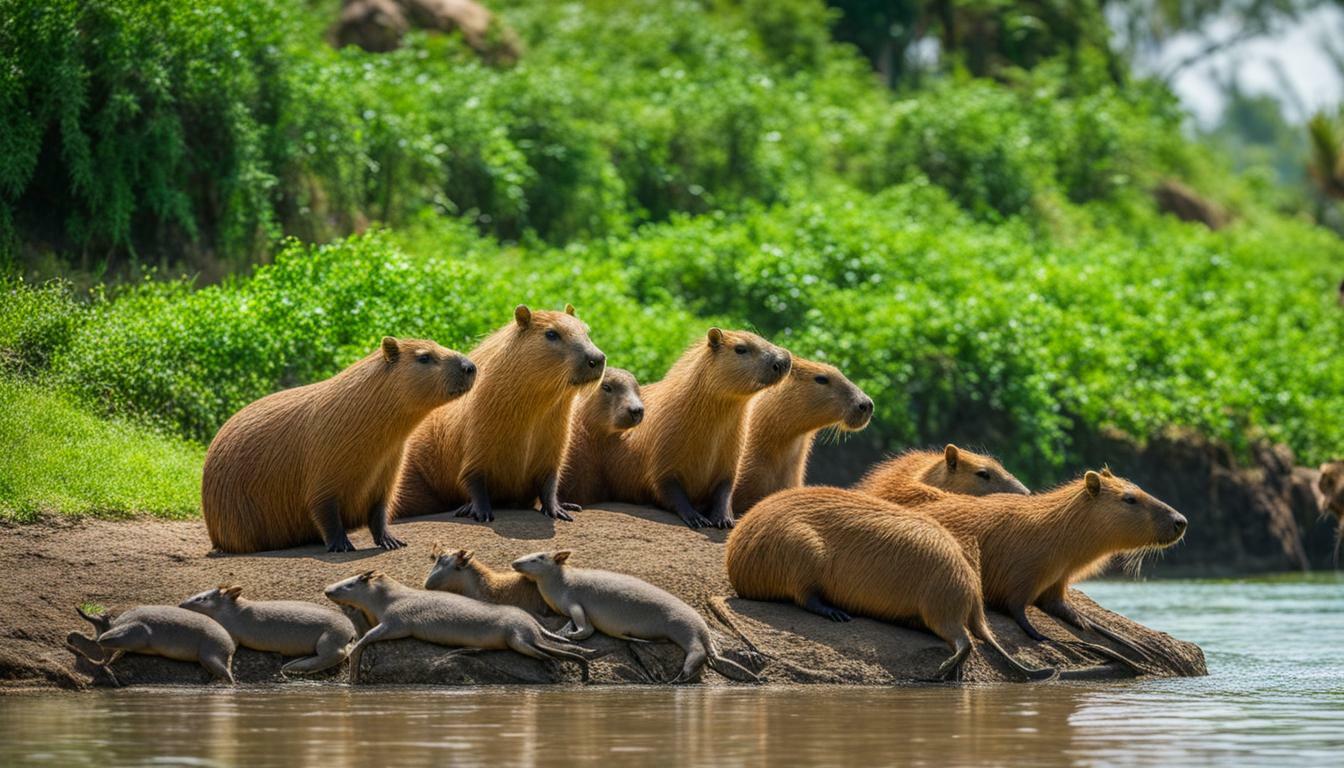Capybaras and crocodiles are known to interact in the wild, but do they truly get along? Despite being fierce predators, crocodiles do not eat capybaras, and the two species are often seen hanging out together in the same waters. The reason for this unusual friendship is not well understood, but it may be because capybaras are too large for crocodiles to swallow. Capybaras are known for their calm and friendly nature, which makes them get along with a variety of other animals including dogs, pelicans, guinea pigs, cats, and even monkeys. Their social behavior and willingness to interact with different species have made them popular among other animals. Overall, capybaras are considered one of the friendliest animals in the animal kingdom.
Key Takeaways:
- Capybaras and crocodiles have a unique relationship in the wild.
- Crocodiles do not eat capybaras, despite being predators.
- Capybaras’ large size may contribute to their safety around crocodiles.
- Capybaras are known for their calm and friendly nature.
- They have friendly interactions with a variety of other animals.
Capybara Behavior
Capybaras have a reputation for being friendly and sociable creatures, which may contribute to their ability to get along with other animals. Their calm and gentle nature makes them popular among a variety of species, including dogs, pelicans, guinea pigs, cats, and even monkeys. They are known to form social bonds and engage in cooperative behaviors, making them one of the friendliest animals in the animal kingdom.
In addition to their friendly demeanor, capybaras are highly social animals. They live in groups known as herds or colonies, typically consisting of several individuals. Within these social groups, capybaras engage in various social interactions, such as grooming each other, vocalizing, and sharing resting spaces. This cooperative behavior further enhances their ability to get along with different species.
Capybaras are also excellent swimmers, spending a significant amount of time in the water. They have webbed feet and dense fur that provides buoyancy, making them well-adapted for aquatic environments. This aquatic lifestyle brings them into contact with other water-dwelling species, including crocodiles. Despite the potential threat that crocodiles pose as predators, capybaras and crocodiles often coexist peacefully, sharing the same waters without any signs of aggression or predation.
| Species | Interaction with Capybaras |
|---|---|
| Dogs | Playful interactions, often seen chasing each other or lounging together |
| Pelicans | Capybaras and pelicans can be found resting or foraging together in wetland areas |
| Guinea Pigs | Form close bonds and engage in social grooming |
| Cats | Some cats have been known to form unlikely friendships with capybaras |
| Monkeys | Capybaras and monkeys often interact peacefully, sometimes even sharing food |
While the exact reasons for capybaras’ ability to form these unusual friendships with other animals, including crocodiles, are not yet fully understood, their friendly nature and social behavior certainly play a crucial role. It is fascinating to observe these interactions and the harmonious coexistence between capybaras and species that would traditionally be considered their predators or competitors.
Crocodile Behavior
Crocodiles, as fierce predators, play a significant role in the animal kingdom, but how does this impact their interactions with capybaras? Let’s explore the behavior of crocodiles to understand their relationship with these friendly creatures.
First and foremost, crocodiles are known for their stealth and patience when it comes to hunting. They are highly skilled ambush predators, lurking beneath the waters to catch their prey by surprise. Their powerful jaws and sharp teeth make them formidable hunters, capable of taking down large animals.
When it comes to capybaras, however, crocodiles display a rather surprising behavior. Despite having the opportunity to prey on these herbivorous rodents, crocodiles rarely do so. It is believed that the size of capybaras acts as a deterrent for crocodiles, as they are simply too large for the reptiles to swallow. This unique aspect of capybara physiology may explain why they are not considered viable prey for crocodiles.
Furthermore, crocodiles are solitary animals and are highly territorial in nature. They prefer to establish their own hunting grounds and defend them from other crocodiles. This territorial behavior may also contribute to their minimal aggression towards capybaras, as long as the capybaras do not encroach upon their territory or pose a threat.
Predator-Prey Interactions
It is important to note that while crocodiles do not typically prey on capybaras, there have been instances where crocodiles have attacked and killed them. These instances are rare and often occur when capybaras venture too close to the water’s edge or are caught off guard. This highlights the inherent risk that capybaras face when sharing the same environment as crocodiles.
In conclusion, crocodiles and capybaras have an intriguing relationship. While crocodiles are fierce predators, they do not commonly prey on capybaras due to their large size. However, it is crucial to remember that interactions between these two species can still pose a risk for capybaras. Understanding the behavior of both crocodiles and capybaras helps shed light on the complex dynamics of predator-prey relationships in the animal kingdom.
| Key Points |
|---|
| Crocodiles rarely prey on capybaras due to their large size. |
| Crocodiles are solitary and territorial animals, which may affect their interactions with capybaras. |
| Interactions between crocodiles and capybaras can still pose a risk for the latter. |
Wildlife Interactions
Understanding the dynamics of wildlife interactions is essential in determining whether capybaras and crocodiles can truly get along. In the natural world, different species often interact with each other, sometimes forming unexpected relationships. These interactions can range from predator-prey relationships to symbiotic partnerships, where both species benefit.
When it comes to capybaras and crocodiles, their relationship falls into the category of interspecies dynamics. Despite being formidable predators, crocodiles do not prey on capybaras. In fact, these two species are often observed sharing the same waters and even resting close to each other. This unusual behavior has caught the attention of researchers and wildlife enthusiasts alike.
One possible explanation for this friendship is the size difference between the two species. Capybaras, which can weigh up to 150 pounds, are simply too large for crocodiles to consider them as prey. Therefore, there is no threat of predation, allowing the capybaras and crocodiles to coexist peacefully. This unique interaction showcases the complexity and adaptability of wildlife, where unexpected bonds can form.
| Capybara & Crocodile Interaction | Example |
|---|---|
| Sharing the same waters | Capybaras and crocodiles are often seen in close proximity, basking in the sun or swimming together. |
| Resting in proximity | It is not uncommon to find capybaras and crocodiles lying near each other, displaying a peaceful coexistence. |
| Non-predatory behavior | Crocodiles do not view capybaras as prey and do not pose a threat to them. |
Interspecies Dynamics in the Animal Kingdom
The interaction between capybaras and crocodiles highlights the intricate web of relationships that exist in the animal kingdom. Wildlife interactions, such as those between these two species, can play a vital role in the balance of ecosystems. These interactions shape the behavior and survival strategies of different organisms, contributing to the overall functioning of the natural world.
While the exact reasons for the capybara-crocodile friendship may not be fully understood, it serves as a reminder that wildlife interactions are complex and often defy our expectations. Observing and studying these interactions can provide valuable insights into the delicate equilibrium of nature.
Whether it’s the unlikely companionship between capybaras and crocodiles or the symbiotic relationships between different species, wildlife interactions continue to fascinate and intrigue us. Exploring these dynamics helps us appreciate the interconnectedness of all living creatures and the importance of conservation efforts to preserve these intricate relationships.
Capybaras and Crocodiles: Unusual Friendship
Capybaras and crocodiles have formed an unusual friendship, often seen sharing the same waters, but what drives this unlikely relationship? While crocodiles are fierce predators, they do not prey on capybaras, and instead, the two species coexist peacefully. One possible explanation for this is the size difference between the two animals. Capybaras, known for their calm and friendly nature, are simply too large for crocodiles to swallow. This makes them an unlikely target for the predators, allowing them to share habitats without conflict.
It’s not just crocodiles that capybaras get along with. These sociable creatures have been observed forming friendships with a variety of other animals, including dogs, pelicans, guinea pigs, cats, and even monkeys. Their calm temperament and willingness to interact with different species make them popular among other animals in the natural world.
This unusual interspecies friendship showcases the fascinating world of wildlife interactions. It highlights how different species can cohabit and even form bonds in their natural habitats. Capybaras and crocodiles serve as a testament to the diverse and complex web of ecological relationships that exist within ecosystems, challenging our preconceived notions of predator-prey dynamics.
| Animals that Capybaras Get Along With |
|---|
| Dogs |
| Pelicans |
| Guinea pigs |
| Cats |
| Monkeys |
As we continue to explore the intricacies of wildlife interactions, the friendship between capybaras and crocodiles serves as a reminder that nature is full of surprises. While we may not fully understand the underlying motivations for these relationships, we can appreciate the beauty and complexity of coexistence in the animal kingdom.
Explanations for the Friendship
Scientists have proposed various hypotheses to explain why capybaras and crocodiles seem to get along, but a definitive answer remains elusive. One possible explanation is that capybaras are simply too large for crocodiles to swallow. As the largest rodent species in the world, capybaras can weigh up to 150 pounds, making them a formidable prey for even the largest crocodiles. This size difference may deter crocodiles from viewing capybaras as a potential meal, leading to a more relaxed coexistence.
Another hypothesis suggests that capybaras and crocodiles have developed a symbiotic relationship over time. Crocodiles are known to prey on smaller animals that inhabit the same ecosystems as capybaras, such as fish and birds. By associating with capybaras, crocodiles may benefit from the smaller prey that are attracted to the capybara’s presence. In return, capybaras may benefit from the protection provided by the crocodiles, as their presence may deter other predators from approaching.
Furthermore, the social nature of capybaras could play a role in their ability to interact positively with other species, including crocodiles. Capybaras are highly social animals, often found living in large groups called herds. Their natural inclination to form social bonds and establish peaceful relationships with other animals may explain their ability to coexist with crocodiles. This sociability and friendly nature have also been observed in capybara interactions with a variety of other species, further highlighting their adaptability.
| Capybaras and Crocodiles: Unusual Friendship | Explanations for the Friendship |
|---|---|
| Capybaras are too large for crocodiles to swallow. | Size difference deters crocodiles from considering capybaras as prey. |
| Capybaras and crocodiles may have a symbiotic relationship. | Associating with capybaras may provide crocodiles with access to smaller prey, while capybaras benefit from the protection provided by crocodiles. |
| Capybaras’ social nature contributes to their ability to interact positively with other species. | The sociability and friendly nature of capybaras allow them to establish peaceful relationships with crocodiles and other animals. |
In conclusion, the friendship between capybaras and crocodiles is a unique phenomenon in the animal kingdom. While scientists have proposed various hypotheses to explain this unusual relationship, a definitive answer remains uncertain. The size difference, potential symbiosis, and capybaras’ social behavior are all factors that may contribute to their ability to get along with crocodiles. By examining these ecological relationships and wildlife interactions, we can gain a deeper understanding of the complex dynamics that exist within our natural world.
Capybaras’ Social Nature
Capybaras’ innate sociability and their willingness to interact with different animals have made them popular among other species. These friendly rodents are known for their calm demeanor and gentle nature, which allows them to develop unique relationships with a variety of creatures. One such example is their unusual friendship with crocodiles, despite the latter being fierce predators.
Capybaras and crocodiles can often be spotted sharing the same waters, seemingly unperturbed by each other’s presence. This unexpected cohabitation has raised questions about the nature of their relationship. While the exact reason for this friendship is not fully understood, it is speculated that capybaras’ large size may play a crucial role. These rodents are simply too big for crocodiles to swallow, reducing the predatory threat and potentially fostering a sense of security.
Interestingly, capybaras’ social behavior extends beyond their interactions with crocodiles. They are known to form bonds with a diverse range of animals, including dogs, pelicans, guinea pigs, cats, and even monkeys. Their affable nature and propensity for socializing have earned them the reputation of being one of the friendliest animals in the animal kingdom.
Overall, capybaras’ ability to forge connections with other species highlights the fascinating dynamics of wildlife interactions. Their amiable nature, combined with their size advantage over predators like crocodiles, allows them to coexist harmoniously with a variety of creatures, defying traditional expectations in the animal kingdom.
| Animal | Interaction |
|---|---|
| Dogs | Playful companionship |
| Pelicans | Sharing water bodies |
| Guinea pigs | Peaceful cohabitation |
| Cats | Curious friendships |
| Monkeys | Social interactions |
Capybaras and Other Friendly Species
In addition to crocodiles, capybaras have been observed peacefully coexisting with a range of animals, including dogs, pelicans, guinea pigs, cats, and monkeys. Their friendly nature and social behavior make them highly adaptable and able to form bonds with different species.
One of the reasons capybaras get along well with other animals is their calm and non-confrontational demeanor. They have a laid-back approach to life, which allows them to interact with different species without aggression or fear. This gentle nature makes them an appealing companion for a wide variety of animals.
Table:
| Animal | Reason for Coexistence |
|---|---|
| Dogs | Capybaras and dogs often form playful friendships, engaging in activities such as chasing each other or cuddling together. |
| Pelicans | While pelicans are normally associated with waterbirds, they have been observed peacefully cohabitating with capybaras, sharing the same habitats and occasionally even perching on their backs. |
| Guinea Pigs | Capybaras and guinea pigs belong to the same family, making them genetically similar. This similarity may contribute to their peaceful coexistence. |
| Cats | Cats have been known to form friendships with capybaras, with the two species often seen lounging together or grooming each other. |
| Monkeys | Despite their differences in size and behavior, capybaras and monkeys have been observed interacting in a harmonious way. They seem to enjoy each other’s company and engage in playful activities. |
Overall, capybaras are known for their ability to form friendships with various animals. Their friendly nature and willingness to coexist peacefully with different species make them a fascinating part of the animal kingdom. Whether it’s with crocodiles or other unlikely companions, capybaras demonstrate that harmony and cohabitation can exist even in the most diverse ecosystems.
Conclusion
The unusual friendship between capybaras and crocodiles highlights the complexities of wildlife interactions, but the exact nature of their relationship remains a subject of fascination and ongoing research. Capybaras and crocodiles are known to get along well despite their stark differences. While crocodiles are fierce predators, capybaras seem to be exempt from their menu. This peculiar friendship may be attributed to the capybaras’ size, as they are too large for crocodiles to swallow.
Capybaras’ calm and friendly nature plays a significant role in their ability to coexist harmoniously with other creatures. This amiable disposition allows capybaras to establish bonds with a variety of animals, including dogs, pelicans, guinea pigs, cats, and even monkeys. Their social behavior and willingness to interact with different species have made them highly regarded among other animals in various ecosystems.
Widely considered one of the friendliest animals in the animal kingdom, capybaras exemplify the possibility of peaceful cohabitation among diverse species. Their capacity to form unusual friendships with crocodiles and other animals sheds light on the remarkable adaptability of wildlife and the intricate web of ecological relationships that exist in the natural world. While much remains to be discovered about the specific mechanisms that enable these interactions, the bond between capybaras and crocodiles serves as a reminder of the wonders of nature and the continuous exploration that fuels our understanding of it.
FAQ
Do capybaras and crocodiles get along?
Yes, capybaras and crocodiles are known to get along well and can often be seen hanging out together in the same waters.
Why do crocodiles not eat capybaras?
The exact reason is not well understood, but it is believed that capybaras are too large for crocodiles to swallow.
What other animals do capybaras get along with?
Capybaras are known for their calm and friendly nature, which makes them get along with a variety of other animals including dogs, pelicans, guinea pigs, cats, and even monkeys.
Why are capybaras considered one of the friendliest animals in the animal kingdom?
Capybaras’ social behavior and willingness to interact with different species have made them popular among other animals, earning them a reputation as one of the friendliest animals in the animal kingdom.




